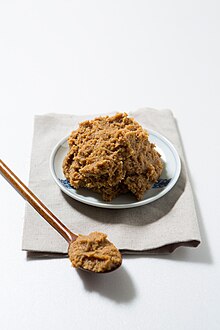Dwenjang
 |
|
| Alternative names | Soybean paste |
|---|---|
| Type | Fermented bean paste |
| Place of origin | Korea |
| Main ingredients | Soybean, brine |
| Other information | Brewed along with ganjang |
| |
|
| Korean name | |
| Hangul | 된장 |
|---|---|
| Hanja | -醬 |
| Revised Romanization | doenjang |
| McCune–Reischauer | toenjang |
| IPA | [twe̞n.dʑaŋ] |
Doenjang (된장; "thick sauce") or soybean paste is a type of fermented bean paste made entirely of soybean and brine. It is also a byproduct of soup soy sauce production.
The earliest soybean fermentation in Korea seem to have begun prior to the era of the Three Kingdoms. The Records of the Three Kingdoms, a Chinese historical text written and published in the 3rd century, mentions that "Goguryeo people are good at brewing fermented soybeans." in the section named Dongyi (Eastern foreigners), in the Book of Wei.Jangdoks used for doenjang production are found in the mural paintings of Anak Tomb No.3 from the 4th century Goguryeo.
In Samguk Sagi, a historical record of the Three Kingdoms era, it is written that doenjang and ganjang along with meju and jeotgal were prepared for the wedding ceremony of the King Sinmun in February 683.Sikhwaji, a section from Goryeosa (History of Goryeo), recorded that doenjang and ganjang were included in the relief supplies in 1018, after a Khitan invasion, and in 1052, when a famine occurred.Joseon texts such as Guhwangchwaryo and Jeungbo sallim gyeongje contain the detailed procedures on how to brew good quality doenjang and ganjang.Gyuhap chongseo explains how to pick a date for brewing, what to forbear, and how to keep and preserve doenjang and ganjang.
...
Wikipedia
